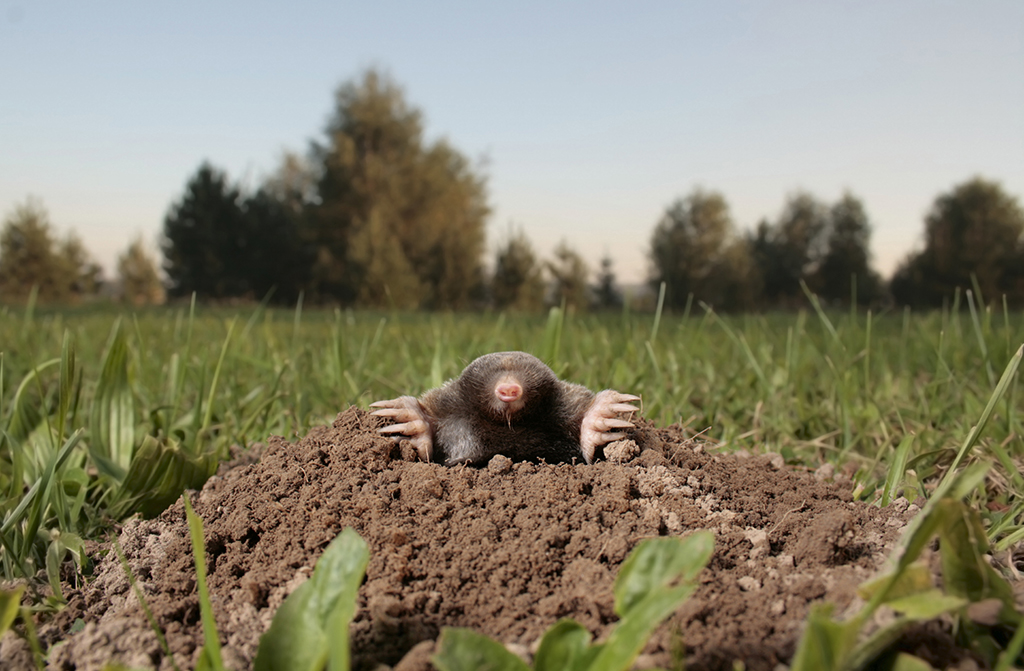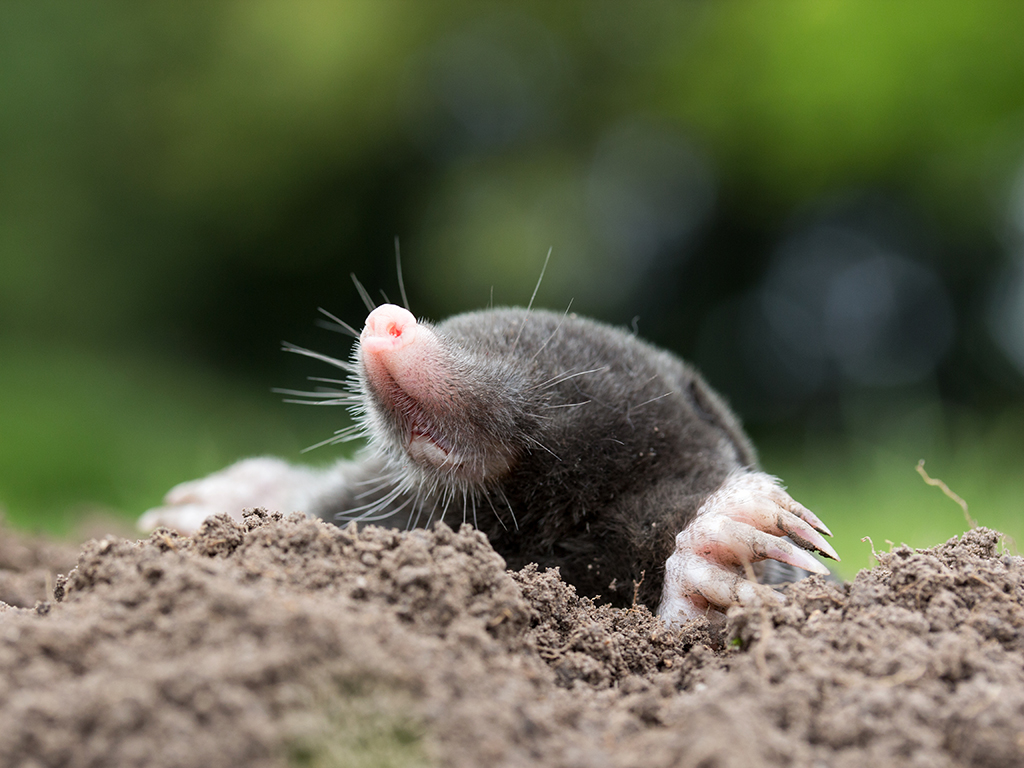
The velvet underground – the world of the mole
Moles have been a groundskeeper’s worst nightmare for centuries and mole catchers today are still perfecting the best way to dispense with these furry pests.
Moles incur wrath – for a society obsessed with immaculately manicured lawns and golf courses, a rash of molehills appearing overnight causes a similar reaction to that of a troubled teenager peering into the mirror and seeing his face covered with acne.
And like the teenager, there are plenty of options available to deal with the problem – many as costly and as effi cacious as walking through a swamp in stilettos. It’s extraordinary the lengths people will go to. Complex labyrinths of mole tunnels have been fi lled with smoke, gas, car exhaust fumes, oil, diesel and strong cleaning solutions, as well as water jets from hosepipes. There is a vast array of sonic gadgets for placing into molehills – each claiming to drive the creatures away – while cayenne pepper and curry powder, mouse traps, loud music, fl apping windmills and fl ame-throwers are just a few of the other ridiculous things people I know have tried in sheer desperation.
It’s not a new problem. In 1566 an Act of Parliament was passed, offering a bounty for killing moles, while the traditional molecatcher could further supplement his income by selling their beautiful skins.
Reports from different areas of the country record moles with considerable colour variation. Most are grey-black, but some may be much paler, even gingery, and on rare occasions white moles have also been found.
Traditionally, every village had its mole-catcher. Highly specialised, these skilled countrymen were competitively reticent and unwilling to share their methodology, prefer ring to load the gibbet with lines of velvet bodies showing off their handiwork.
Moles are widespread, though none can be found in Orkney, Shetland or many of the Hebridean islands. They were accidentally introduced to Mull with a shipment of earth from Morvern and so are widespread there too.
Cameron Thomson, 90, from Lawers in Perth and Kinross, has been trapping moles for more than 60 years, beginning when he was a gardener at Kindrogan, where he found them to be pests.

A mole churning out heaps of earth and destroying pristine lawns
‘I just started out in our garden and then soon found that moles drove the farmers mad, so I used to catch them for them too. I never liked using poison, though sometimes farmers provided me with strychnine. It’s far too indiscriminate; I heard about a young lad who had got it on to his hands, and it killed him. And then someone I was working with got a little on his hands too. He was eating his piece, and tore a bit of bread off for the dog. It died. So I have always employed the traditional trapping methods, but you need to know about moles or else you’ll catch nothing. Some traps, too, are ineffective. The metal ones are best; the old wooden ones are far too heavy to humph about.’
The arrival of strychnine (when worms were dipped in the poison and put into tunnels) saw the demise of the traditional mole-catcher. But a total ban on strychnine in 2007 has not only seen a resurgence in mole numbers, but also the rebirth of the old-school mole-catcher.
Charles Henderson, a former army officer who later worked in the financial services sector with a high-octane job and stressful lifestyle, commuting back and forth to The Hague, had a hankering to return to his rural roots.
He gave it all up to become a freelance gardener in Edinburgh before moving to Perthshire, where he is now part-time head gardener on a sporting estate. Moles manifested themselves on a daily basis, and being fed up with the constant barrowing of the spoils only to find by next day there were even more, he set about solving the problem. He soon realised that, far from being a question of luck, mole-catching involved science, and a huge knowledge and understanding of how these fascinating mammals operate.
Moles are carnivorous. Contrary to popular belief, they are not blind – though eyesight is not their strongest faculty – but their sensory powers are immense, and a strong pig-like snout with its bristly hairs helps them to sense prey.
Their tails, too, are covered with spiky hairs that help them locate worms and invertebrates. It is their massively enlarged ‘diggers’ – front feet with six digits and sharp claws – that are a mole’s most impressive feature. This little mammal can shovel approximately 540 times its own body weight in soil per day. The extensive complexities of some tunnels would put Spaghetti Junction to shame. Breeding chambers are lined with moss and dried grasses where between three to six young – blind and naked – are born.
Meeting Henderson, it is apparent that his subject has become a total obsession; he appears at his happiest while out solving mole issues. For farmers it’s not just a cosmetic issue. Moles are indeed a concern, particularly in silage fields, where their spoil heaps often damage cutting machinery, to say nothing of the disease spread to livestock in the silage through mole faeces and saliva. Listeriosis and e.coli are just two of the diseases that may enter the animal food chain, incurring large vet bills as well as livestock fatalities. Lambs frequently eat the soil from molehills, and fatal e.coli often follows.

The mole’s pig-like nose is very sensitive
Henderson is a perfectionist. He has adapted his mole tool kit with a military attention to detail, modifying everything with precision. He first spies the newly dug hills and then probes the area until he quickly finds an active run where he efficiently sets his trap. ‘Traps have to be strong so that moles are instantly humanely dispatched. Some traps are better than others, but all need to be replaced frequently.’
This is a case where a spade is not always a spade; he shows me a short-handled variety with a small, square head and extra acute edges, and makes an immaculate cut into the soft turf, neatly trowelling out a portion of dark earth before placing the trap into the small hole in the run’s centre. All is then swiftly covered over, the spot marked with a red-topped stake.
‘I like to keep the turf neat, particularly in a lawn, so that once the mole has been caught it is laid back tidily. ’
A mole can excavate at least 80 metres a day, and operates where there is a healthy population of earthworms. Each mole requires in the region of 80% of its own body weight in food a day, and will sometimes gather large stores of worms with their heads bitten off, particularly during the breeding season. Moles have defined territories and are largely solitary, though their tunnels may converge.
Weasels are the mole’s main underground predator. Such is Henderson’s success that, as well as gardening, he now runs a mole-catching business with the strapline, No chemicals, no poisons. No mole, no fee. He is in high demand.
‘My friends tell me that I spend far too much time alone, but it’s a job I love,’ he says. ‘Oddly, I have always hated handling worms and I don’t like coming into contact with them, but here I am out in the fields in all weathers catching moles. I run tutorials, too, and enjoy explaining to customers how they can understand and trap the moles themselves.’
Henderson’s success is all about his total understanding and affinity with this highly specialised and secretive underground movement, and he won’t be making a mountain out of a molehill any day soon.
(This feature was originally published in 2015)
TAGS

